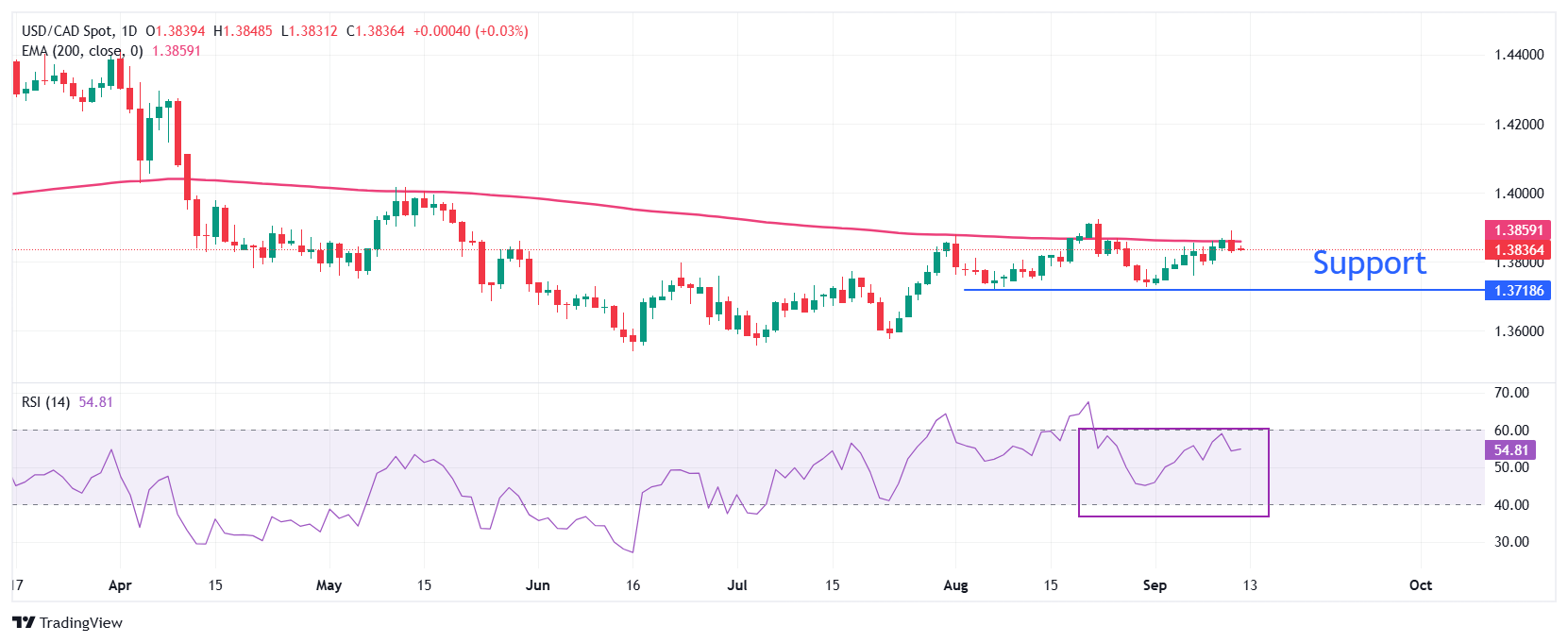USD/CAD Price Forecast: Corrects to near 1.3830 on US stagflation risks
- USD/CAD trades with caution around 1.3830 amid escalating US stagflation risks.
- Investors expect the Fed to cut interest rates in its policy meeting on Wednesday.
- The Canadian Dollar will be influenced by Canada’s CPI and the BoC’s monetary policy next week.
The USD/CAD pair trades cautiously near Thursday’s low around 1.3835 during the European trading session on Friday. The Loonie pair retraces from its recent highs of 1.3890 as the US Dollar (USD) faces selling pressure amid growing United States (US) stagflation risks.
The US economy is facing risks of stagflation amid weakening job growth and rising inflationary pressures. The Department of Labor showed on Thursday that individuals claiming jobless benefits for the first time in the week ending September 5 came in at 263K, the highest figure seen in four years.
In August, the headline Consumer Price Index (CPI) rose at a faster pace of 2.9% on an annualized basis, as expected, against 2.7% in July. Month-on-month headline CPI grew by 0.4%, faster than estimates of 0.3% and the prior reading of 0.2%.
Going forward, the Federal Reserve (Fed) is expected to perform a delicate balancing act in the policy meeting on Wednesday amid escalating US stagflation risks. Meanwhile, the Fed is certain to cut interest rates next week, according to the CME FedWatch tool.
In Canada, investors will focus on the CPI data for August and the Bank of Canada’s (BoC) monetary policy meeting, which are scheduled to next week.
USD/CAD continues to face pressure above the 200-day Exponential Moving Average (EMA), which trades around 1.3847.
The 14-day Relative Strength Index (RSI) oscillates inside the 40.00-60.00 range, indicating a sideways trend.
Going forward, the asset could slide towards the round level of 1.3600 and the June 16 low of 1.3540 if it breaks below the August 7 low of 1.3722.
On the flip side, a recovery move by the pair above the August 22 high of 1.3925 would open the door towards the May 15 high of 1.4000, followed by the April 9 low of 1.4075.
USD/CAD daily chart

US Dollar FAQs
The US Dollar (USD) is the official currency of the United States of America, and the ‘de facto’ currency of a significant number of other countries where it is found in circulation alongside local notes. It is the most heavily traded currency in the world, accounting for over 88% of all global foreign exchange turnover, or an average of $6.6 trillion in transactions per day, according to data from 2022. Following the second world war, the USD took over from the British Pound as the world’s reserve currency. For most of its history, the US Dollar was backed by Gold, until the Bretton Woods Agreement in 1971 when the Gold Standard went away.
The most important single factor impacting on the value of the US Dollar is monetary policy, which is shaped by the Federal Reserve (Fed). The Fed has two mandates: to achieve price stability (control inflation) and foster full employment. Its primary tool to achieve these two goals is by adjusting interest rates. When prices are rising too quickly and inflation is above the Fed’s 2% target, the Fed will raise rates, which helps the USD value. When inflation falls below 2% or the Unemployment Rate is too high, the Fed may lower interest rates, which weighs on the Greenback.
In extreme situations, the Federal Reserve can also print more Dollars and enact quantitative easing (QE). QE is the process by which the Fed substantially increases the flow of credit in a stuck financial system. It is a non-standard policy measure used when credit has dried up because banks will not lend to each other (out of the fear of counterparty default). It is a last resort when simply lowering interest rates is unlikely to achieve the necessary result. It was the Fed’s weapon of choice to combat the credit crunch that occurred during the Great Financial Crisis in 2008. It involves the Fed printing more Dollars and using them to buy US government bonds predominantly from financial institutions. QE usually leads to a weaker US Dollar.
Quantitative tightening (QT) is the reverse process whereby the Federal Reserve stops buying bonds from financial institutions and does not reinvest the principal from the bonds it holds maturing in new purchases. It is usually positive for the US Dollar.

